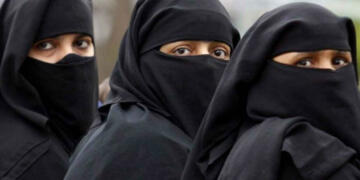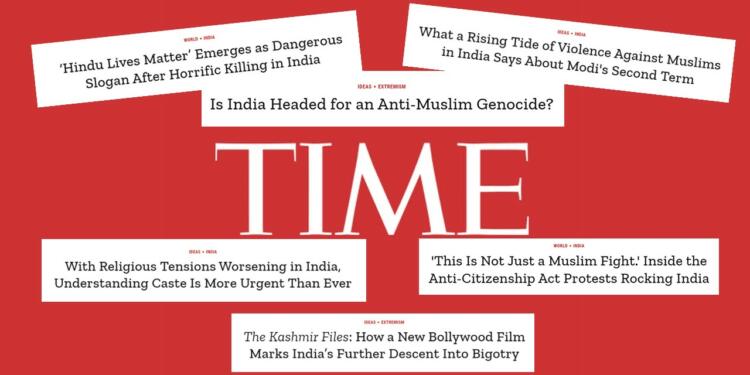“Hindu right-wing”, “Hindu nationalist”, “Hindu supremacists ruling India” … these are some of the blunt adjectives that Prime Minister Narendra Modi’s government is repeatedly bestowed upon by the New-York based news magazine ‘TIME’. In a recent article, India has been unanimously called an “undeclared Hindu state”.
These allegations directed against PM Modi, the ruling party BJP and India, had one word in common and that is “Hindu”. It is crystal clear that TIME, by using the mantle of journalism, is targeting a particular community, while victimising the other in an effort to create a storyline, something like David v/s Goliath.
In most of the articles written on Narendra Modi, the BJP or India, one can easily fall into the belief that India is rapidly transforming into a “Hindu Nation” contrary to its secular stance. The idiom “Hindu Nationalism” is thrown around painting the narrative that Hindus are the most supremacist, fundamentalist and expansionist community in the world. By merely applying the epithet “nationalist” or “supremacist” to Hindus, one of the most peaceful communities in the world, TIME magazine intends to subliminally convey the country, the government and the people’s ill-fated mentality; which to begin with, does not exist at all!

Even after two fair elections yielded two terms in office, it is puzzling that the Western media continues to demonise the head of the biggest democracy. Why should our elected Prime Minister and his government be stigmatized based on his religion? If that logic stands correct, how many non-Christians so far have become heads of state in the US, the UK or Europe? How many western countries have declared themselves secular? Why the word “Hindu” or “nationalism” is often being used as a pejorative?
In one issue, TIME magazine quotes: “The defining idea of Narendra Modi’s landslide 2019 victory is Hindutva, the ideology that defines Indian culture in terms of Hindu values. That could assert itself toward a dangerous conclusion in the next five years if left unchecked.” In another edition, it states “The belief that India is not a secular nation or even multi-religious, but an intrinsically Hindu country is the central platform of India’s ruling Bharatiya Janata Party (BJP).” These instances continue to show TIME’s predetermined belief about India and its political landscape.
Narendra Modi’s government policies targeting economic progress and social security, soon after coming to power in 2014, were side-lined and did not even merit a mention when TIME decided to publish an article on India.
In the flagship schemes of the government like the Swachh Bharat Mission, PM Awas Yojana, Jal Jeevan Mission, Ujala Yojana, PM Ujjwala Yojana, PM Jan Dhan Yojana, Sukanya Samriddhi Yojana, PM KISAN, PM GKAY, MUDRA Yojana or the ECLG Scheme for MSMEs – No such instance where any beneficiary is being disqualified due to their religion has surfaced. On the contrary, ‘SabkaSaath, Sabka Vikas, Sabka Vishwas” has always been the underlying philosophy of the Modi government.
The benefits including – but not limited to – toilets, gas connections, Tap Water connections, electricity, and ration cards were given without any discrimination. Funds for the upliftment of minorities have been escalated and minority welfare schemes have been implemented far more effectively under the Modi government than any of its predecessors. The initiatives of the Modi Government have done more for India’s minorities than those of any of its previous governments.
Muslims and other minorities are now enrolling at higher rates than ever. The discriminatory practice of instant triple talaq has been outlawed. The decision to permit women to perform the Hajj without mehram is a significant step toward the Muslim community’s empowerment. Under the Modi Government, there has been a qualitative change in the lives of people, irrespective of their religion.
Even when Narendra Modi took tough decisions on the issues pertaining to national security, it too was moulded into the model of Hindutva and shown through the prism of nationalism in India (the usage of this word has often been frowned upon in the west due to its association with Nazism).
TIME has also been in controversy for repeatedly giving opinions to India’s hard-line left-wing journalists. It recently gave its headline on the gruesome murder of Kanhaiya Lal by Islamists: ‘Hindu Lives Matter’ Emerges as Dangerous Slogan after Horrific Killing in India”. This headline clearly shows that it was paramount for this particular publication to follow its prejudiced agenda, at the cost of impartial journalism.

Read More: Hindu Lives Matter: A “Dangerous slogan” for Time Magazine
In journalism, sensation sells, especially in today’s digital age where click-bait is swiftly becoming a phenomenon for classifying good and bad. Negative news makes headlines and clicks generate revenue. In such a competitive sphere, TIME is hell-bent on creating a negative picture of India by especially undermining India’s achievements – but to what end? It is logical to conclude that TIME is trying to regain the audience it has lost over the years by making these targeted attacks and unconstructive criticisms of the laws and programmes that have truly improved the lives of Indians.
When it comes to TIME, the spotlight shines primarily on the negativity while the initiatives which have resulted in safeguarding the rights and realising the aspirations of millions are either hidden deep amongst the text (if not ignored completely).

Even after the BJP government has been in power for over eight years, it keeps growing. The hand-picked isolated instances and comments are presented as being representative of the opinions of the nation as a whole, which has over a billion people. Outrage is reserved only for crimes against one particular community and even landmark legislations such as the CAA and abrogation of Article 370 and 35A from Jammu and Kashmir which empower marginalised communities are not spared.


Also Read: Dear Time magazine, presenting truth is not ‘promoting bigotry’
TIME has left no stone unturned to stigmatize the word Hindu, Nationalism and Hindutva. The propaganda against the current government and the Prime Minister has reached its pinnacle since 2014. It is as if TIME is deliberately trying to defame Hinduism and undermine India’s global credibility.
While criticism is the cardinal element of journalism, it must also be part of a journalist’s code to present his or her views in a factual-balanced manner and speak to all its key stakeholders, be it politicians, policymakers, government officials, media and independent analysts. It is unethical for a prestigious institute like TIME to voice an unsubstantiated judgment. Unfortunately, ivory-tower labelling, vague platitudes and the use of “Hindu Nationalism” as a framing device have become the norm. It is therefore very clear that there is a double standard at work already.
Also Read: Islamist Mullah Baradar is a ‘moderate’ leader, PM Modi is a ‘Hindu Extremist’ for the TIME magazine

With selective reporting, anti-Hindu narratives are also being normalised — evident from a recent Rutgers study found that thousands of instances where a “sharp rise and evolving patterns of hate speech directed toward the Hindu community across numerous social media platforms.” was observed. To every concerned reader, TIME’s articles look like a hostile psychological operation, which if left unchecked, may very well result in more incidents of discrimination, racism and violence against the Hindu community while simultaneously propagating hatred towards Indians irrespective of their religious beliefs.
Article authored by:
Vasudha Madhogaria





























